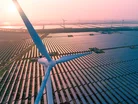IEA: Global Renewables Lagging Behind COP28 Climate Targets

One of the leading associations at the heart of the energy transition has said more needs to be done to ensure countries around the world can align their renewable energy goals with those set out at COP28.
Among the latest reports published by the International Energy Agency (IEA) is COP28 Tripling Renewable Capacity Pledge: Tracking countries’ ambitions and identifying policies to bridge the gap, which investigates how renewable power capacity is reflected in existing government commitments.
The study was published with the financial backing of the European Union (EU) as part of its funding of the Clean Energy Transitions in Emerging Economies programme as part of the IEA’s Clean Energy Transitions Programme.
It delves into whether countries are set to achieve their ambitions by 2030, as set out by delegates at COP, how they measure against COP28 pledges and how to address any disparities.
How can countries meet COP28 targets?
“By delivering on the goals agreed at COP28 – including tripling renewables and doubling energy efficiency improvements by 2030 – countries worldwide have a major opportunity to accelerate progress towards a more secure, affordable and sustainable energy system,” said Dr Fatih Birol, the IEA’s Executive Chairman.
“The IEA will continue to support governments around the world in efforts to achieve this.”
Although the report reveals a discrepancy between countries’ renewable energy ambitions and the goals set at COP28, the IEA says Nationally Determined Contribution (NDC) processes offer a pathway for governments to enhance their efforts in the coming months.
What are NDCs?
As defined by the United Nations (UN), an NDC is a climate action plan to cut emissions and adapt to climate impacts. Each Party to the Paris Agreement is required to establish an NDC and update it every five years.
They are short- to medium-term plans that detail what countries will do to help meet the global goal to pursue 1.5°C — as stated in the Paris Agreement — to adapt to climate impacts and ensure sufficient finance to support these efforts.
The UN says NDCs represent politically backed commitments by countries and, if used correctly, are a key way of tackling a multitude of the world’s current crises.
What targets need to be reached by 2030?
COP28 saw the first formal setting out of 2030 targets globally, which involve tripling renewable power capacity, doubling energy efficiency improvements, significantly reducing methane emissions and accelerating the transition away from fossil fuels.
Despite this, the IEA found that few countries have set explicit 2030 targets for renewable capacity in their NDCs. Current commitments amount to 1,300GW, which the IEA says is 12% of what is needed to meet COP28’s objective. On the other hand, the IEA’s analysis shows that domestic ambitions could lead to nearly 8,000GW of global installed capacity by 2030.
The research indicates that tripling global renewable capacity by 2030 is ambitious but achievable, with record-breaking deployment rates, sector momentum and increased competitiveness with fossil fuels — especially solar PV and wind — driving the growth of adoption.
If 2030 ambitions are realised, the IEA expects solar PV capacity to exceed hydropower, which it coined as the largest renewable source in 2022. This is because more countries are targeting wind and solar PV than dispatchable renewables, with 64 countries setting goals for solar PV and 61 for wind, compared to 47 for hydropower and 31 for bioenergy.
Key challenges will remain, whether they be lengthy permitting processes, insufficient grid infrastructure investment, the need for efficient integration of variable renewables and high financing costs, particularly in developing economies.
So, what next? Tailored policy priorities for different economic contexts, the IEA says.
Advanced economies need to streamline permitting processes, ensure sufficient and skilled staffing and engage local communities to expedite renewable energy expansion for these goals to be attainable and keep global climate success in sight.
*******************
Make sure you check out the latest edition of Energy Digital Magazine and also sign up to our global conference series - Sustainability LIVE 2024.
*******************
Energy Digital is a BizClik brand.
- Meet JERA Nex: Japan's Largest Energy Firm’s Renewables ArmRenewable Energy
- Fossil Fuel Giants: Should They Pay for Climate Damages?Sustainability
- Viasat’s Enhanced Hybrid Network to Benefit Energy SectorTechnology & AI
- GlobalData: Renewables to Lead Italy’s Energy Mix by 2035Sustainability

